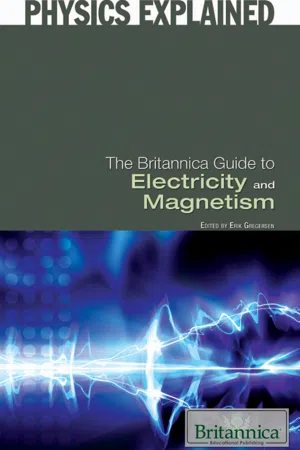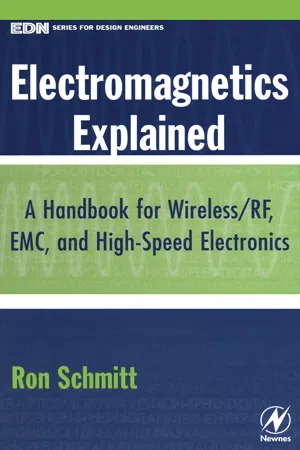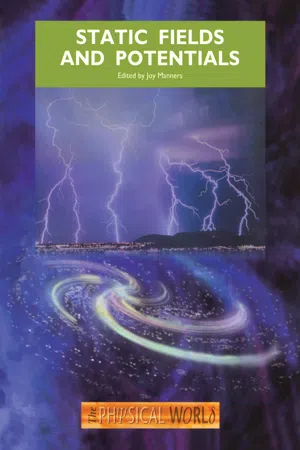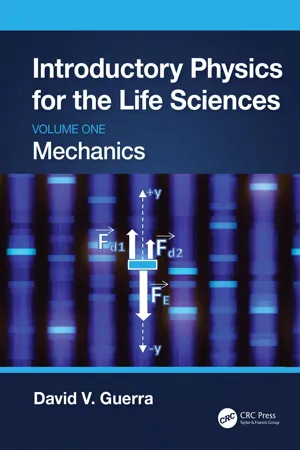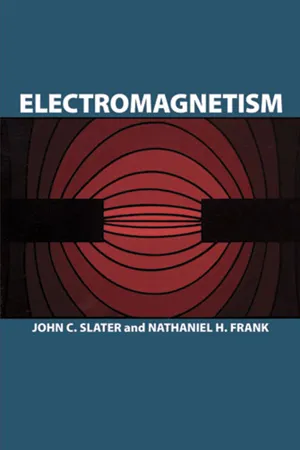Physics
Magnetic Forces and Fields
Magnetic forces and fields refer to the interactions and properties associated with magnets and magnetic materials. These forces are responsible for the attraction or repulsion between magnetic objects and are described by the magnetic field, which is a region where magnetic forces are exerted. Understanding magnetic forces and fields is crucial for various applications, including electromagnetism and magnetic storage technologies.
Written by Perlego with AI-assistance
Related key terms
Related key terms
1 of 4
Related key terms
1 of 3
9 Key excerpts on "Magnetic Forces and Fields"
- eBook - ePub
- A. L. Stanford, J. M. Tanner(Authors)
- 2014(Publication Date)
- Academic Press(Publisher)
16Magnetic Fields I
Publisher Summary
This chapter discusses magnetism, which refers to a group of phenomena that result from forces acting on charges because of the motion of those charges. These magnetic forces exerted on moving charges are usually described in terms of magnetic fields in a way that is similar to that of describing forces exerted on static charges in terms of electric fields. Thus, electric fields have their origins in static charges, and magnetic fields originate within moving charges. Increasing the charge or speed of the particle or increasing the magnitude of the magnetic field causes a proportionate increase in the magnitude of the magnetic force on the particle. The simple name, magnetic field, is sometimes called by more impressive names such as magnetic induction, magnetic flux density, and magnetic field induction. This frequency, which is independent of the speed of the particle, is sometimes called the cyclotron frequency.Magnetism refers to a group of phenomena that results from forces that act on charges because of the motion of those charges. These magnetic forces exerted on moving charges are usually described in terms of magnetic fields in a way that is similar to that of describing forces exerted on static charges in terms of electric fields. Thus, electric fields have their origins in static charges, and magnetic fields originate within moving charges.We will describe magnetic forces in terms of fields by considering:1. How the presence of a magnetic field causes force to be exerted on moving charges. 2. How magnetic fields are themselves produced by moving charges.16.1 Magnetic Forces on Moving Charges
Just as the electric field E is defined at a point in terms of the force F e = q E on a static charge q at that point, we may define the magnetic field B at a point in terms of a force relationship between the magnetic field and a moving charge. The magnetic field B - Britannica Educational Publishing, Erik Gregersen(Authors)
- 2010(Publication Date)
- Britannica Educational Publishing(Publisher)
CHAPTER 5 THE FUNDAMENTALS OF ELECTROMAGNETISME lectromagnetism encompasses charge and the forces and fields associated with charge. Electricity and magnetism are two aspects of electromagnetism.Electricity and magnetism had been known for millennia, but it was not until the 19th century that they were understood to be related. In 1864, James Clerk Maxwell formulated a theory that related the two, and in 1905, Albert Einstein’s special theory of relativity showed that they were two facets of the same phenomenon. Realization of the unity of electricity and magnetism was so long in coming because electric and magnetic forces behave very differently and can be described with different equations. One great difference between the two is that electric forces arise from charges that can be either stationary or moving, but magnetic forces come from and act upon moving charges only.Electric phenomena take place throughout the universe. Even in matter that has no net positive or negative charge, electric effects are present because of the forces between the individual charges. The electric force is much stronger than that of gravity. For two electrons, the repulsive Coulomb force between them is 1042 times stronger than the attractive gravitational force.The regions in which electric and magnetic forces can exert their effects are called electric and magnetic fields. Electric and magnetic forces do not have a distance limit, so the fields can be measured far from the original charges that generate them. A magnetic field can give rise to an electric field, and an electric field can give rise to a magnetic field. A changing magnetic field produces an electric field, as the English physicist Michael Faraday discovered in work that forms the basis of electric power generation. Conversely, a changing electric field produces a magnetic field, as the Scottish physicist James Clerk Maxwell deduced. The mathematical equations formulated by Maxwell incorporated light and wave phenomena into electromagnetism. He showed that electric and magnetic fields travel together through space as waves of electromagnetic radiation, with the changing fields mutually sustaining each other. Examples of electromagnetic waves traveling through space independent of matter are radio and television waves, microwaves, infrared rays, visible light, ultraviolet light, X-rays, and gamma rays. All of these waves travel at the same speed—namely, the velocity of light (roughly 300,000 kilometres, or 186,000 miles, per second). They differ from each other only in the frequency at which their electric and magnetic fields oscillate.- eBook - ePub
Electromagnetics Explained
A Handbook for Wireless/ RF, EMC, and High-Speed Electronics
- Ron Schmitt(Author)
- 2002(Publication Date)
- Newnes(Publisher)
3 FUNDAMENTALS OF MAGNETIC FIELDSThe other half of electromagnetics is of course the magnetic field. Magnetic fields are inherently different and more difficult to grasp than electric fields. Whereas electric fields emanate directly from individual charges, magnetic fields arise in a subtle manner because there are no magnetic charges. Moreover, because there are no magnetic charges, magnetic field lines can never have a beginning or an end. Magnetic field lines always form closed loops.You may have heard that some particle physicists have been searching for magnetic charges (or “magnetic monopoles,” as the particle physicists call them) in high-energy experiments. In fact, many unified theories of physics require such particles. However, at this point such particles have not been found. Even if they were to be found, they would be so rare as to be inconsequential to everyone except the particle physicists and cosmologists. Instead of hoping for magnetic charges to bail us out, you need to just accept the fact that magnetic fields are inherently different from electric fields. In Chapter 6 , when you learn about relativity, you will learn how the magnetic and electric field phenomena are related in the same manner as space and time. Just as space and time are very different but taken together form an interwoven entity, so do the electric and magnetic fields.MOVING CHARGES: SOURCE OF ALL MAGNETIC FIELDS
Without magnetic charges, magnetic fields can only arise indirectly. In fact, all magnetic fields are generated indirectly by moving electric charges. It is a fundamental fact of nature that moving electrons, as well as any other charges, produce a magnetic field when in motion. Electrical currents in wires also produce magnetic fields because a current is basically the collective movement of a large number of electrons. A steady (DC) current through a wire produces a magnetic field that encircles the wire, as shown in Figure 3.1 - eBook - ePub
- Joy Manners(Author)
- 2020(Publication Date)
- CRC Press(Publisher)
I experienced a miracle … as a child of four or five when my father showed me a compass … [I realized] there had to be something behind objects that lay deeply hidden.’The topics covered in this chapter range from the forces between current-carrying wires through to the discovery of the radiation belts surrounding the Earth. However, throughout our exploration of these subjects, one concept will figure prominently — the idea of a magnetic field.The remainder of this chapter is divided into five main sections.- Section 2 is aimed at defining and describing what we mean by a magnetic field.
- Section 3 is devoted to the generation of magnetic fields by moving charges.
- Section 4 is an examination of the origin of the startling behaviour of the materials that we call ‘magnetic’.
- Sections 5 and 6 are aimed at describing the motion of charged particles in uniform and non-uniform fields respectively. These will include descriptions of several technological devices and natural phenomena that can be explained using your new understanding.
Figure 4.1 Paper clips attracted to a magnet.2 The magnetic field
2.1 Charged particles in electric and magnetic fields
You will recall from Chapter 1 that the field concept was very useful in describing a force that can act at any point within a specified region. In particular, if there is an electric fieldℰ(r) in a certain region such as that shown in Figure 4.2 , then the force on a charge q at position r in the region is given by( r )4.1F el( r )= q ℰ( r ).Equation 4.1 can be used in two ways. A measurement of the force on a known charge serves to define the electric field at that point. Alternatively, if the field is known, it can be used to predict the force on a charge placed in the field. It is important to remember that the electrostatic force acts on all charged particles, whether they are moving or stationary. - David V. Guerra(Author)
- 2023(Publication Date)
- CRC Press(Publisher)
6 Magnetic Forces
DOI: 10.1201/9781003308065-66.1 Introduction
If you have ever used a magnet to pick up a paper clip, you have experienced the magnetic force. This force of nature is normally combined with the electric force from the previous chapter into one force of nature called the electromagnetic force. As you read through this chapter, it will become apparent that both these forces, electric and magnetic, are associated with the electrical charge of an object. Therefore, in this chapter, the magnetic force will be computed with the quantities of electrical current and electric charge. Examples of each type of force calculation will be presented and the definition of the magnetic field will be established. The connection between the analyses employed in the study of torques will also be presented to complement and spiral with the sequence of analysis established in the first three chapters of the text.- Chapter question: An MRI (Magnetic Resonance Imaging) is a sophisticated piece of medical machinery that allows doctors to see soft tissue in a way that X-ray cannot. The word magnetic is part of the acronym by which these devices are known, so what is the role of the magnetic in MRI? This question will be answered at the end of this chapter after the concepts of magnetic forces and magnetic fields are studied.
6.2 Magnets
The simplest place to start a discussion about magnetic phenomena is a bar magnet, which is most likely some composite of iron, cobalt, and nickel that has been magnetized by placing it near another strong magnet. These metals that hold their magnetic field are called ferromagnets. If a bar magnet, like the one in Figure 6.1 , is split in half, each half will have a north and a south pole.FIGURE 6.1 Magnet poles (N’s and S’s) cannot be separated.If each half is split over and over again, each piece will still have both poles. In fact, atoms, electrons, protons, and neutrons have both a north and a south pole. If we split a magnet in half and then flip one of the magnets, the like poles will face each other, and the magnets will repel. See Figure 6.1- eBook - ePub
- Clive Maxfield, John Bird, Tim Williams, Walt Kester, Dan Bensky(Authors)
- 2011(Publication Date)
- Newnes(Publisher)
Chapter 21 Magnetic Fields Ron SchmittMagnetic fields are inherently different and more difficult to grasp than electric fields. Whereas electric fields emanate directly from individual charges, magnetic fields arise in a subtle manner because there are no magnetic charges. Moreover, because there are no magnetic charges, magnetic field lines can never have a beginning or an end. Magnetic field lines always form closed loops. You may have heard that some particle physicists have been searching for magnetic charges (or “magnetic monopoles,” as the particle physicists call them) in high-energy experiments. In fact, many unified theories of physics require such particles. However, at this point such particles have not been found. Even if they were to be found, they would be so rare as to be inconsequential to everyone except the particle physicists and cosmologists. Instead of hoping for magnetic charges to bail us out, you need to just accept the fact that magnetic fields are inherently different from electric fields.21.1 Moving Charges: Source of All Magnetic Fields
Without magnetic charges, magnetic fields can only arise indirectly. In fact, all magnetic fields are generated indirectly by moving electric charges. It is a fundamental fact of nature that moving electrons, as well as any other charges, produce a magnetic field when in motion. Electrical currents in wires also produce magnetic fields because a current is basically the collective movement of a large number of electrons. A steady (DC) current through a wire produces a magnetic field that encircles the wire, as shown in Figure 21.1 .Figure 21.1 Magnetic field lines surrounding a current-carrying wireA single charge moving at constant velocity also produces a tubular magnetic field that encircles the charge, as shown in Figure 21.2 . However, the field of a single charge decays along the axis of propagation, with the maximum field occurring in the neighborhood of the charge. The law that describes the field is called the Biot-Savart law - eBook - ePub
- John C. Slater, Nathaniel H. Frank(Authors)
- 2012(Publication Date)
- Dover Publications(Publisher)
The study of forces, on the other hand, is difficult and complex. The first forces brought into mathematical formulation were gravitational forces, as seen in planetary motion. Next were elastic forces. Then followed electric and magnetic forces, which are the subject of this volume. Their study was mostly a product of the nineteenth century. During the present century, it has become clear that electromagnetic forces are of far wider application than was first supposed. It has become evident that, instead of being active only in electrostatic and magnetostatic experiments, and in electromagnetic applications such as the telegraph, dynamo, and radio, the forces between the nuclei and electrons of single atoms, the chemical forces between atoms and molecules, the forces of cohesion and elasticity holding solids together, are all of an electric nature. We might be tempted to generalize and suppose that all forces are electromagnetic, but this appears to be carrying things too far. The prevailing evidence at present indicates that the intranuclear forces, holding together the various fundamental particles of which the nucleus is composed, are not of electromagnetic origin. These forces, of enormous magnitude, and appearing in the phenomena of radioactivity and of nuclear fission, appear subject to laws somewhat analogous to the electromagnetic laws, but fundamentally different. In spite of this, the range of phenomena governed by electromagnetic theory is very wide, and it carries us rather far into the structure of matter, of electrons and nuclei and atoms and molecules, if we wish to understand it completely. The equations underlying the theory, Maxwell’s equations, are relatively simple, but not nearly so simple as Newton’s laws of motion. Instead of stating the whole fundamental formulation of the subject in the first chapter, as one can when dealing with mechanics, about half of the present book is taken up with a complete formulation of Maxwell’s equations. We start with simple types of force, electrostatic and magnetostatic, and gradually work up to problems of electromagnetic induction and related subjects, all of which are formulated in Maxwell’s equations.In the development of electromagnetic theory, there has been a continual and significant trend, which in a way has set the pattern for the development of all of theoretical physics. This has been the trend away from the concept known as “action at a distance” toward the concept of field theory. The classical example of action at a distance is gravitation, in which simple nonrelativistic theory states that any two particles in the universe exert a gravitational force on each other, acting along the line joining them, proportional to the product of their masses, and inversely proportional to the square of the distance between them. Such a force, depending only on the positions of the particles, quite independent of any intervening objects, is simple to think about, and formed the basis of most of physical thought from the time of Newton, in the latter half of the seventeenth century, on well into the nineteenth century. The first electric and magnetic laws to be discovered fitted in well with the pattern. First among these was Coulomb’s law. Coulomb investigated the forces between electrically charged objects, and found that the force between two such objects was in the line joining them, proportional to the product of their charges (which could be defined by an experiment based on this observation), and inversely proportional to the square of the distance between them, in striking analogy to the law of gravitation. Magnets similarly fell in with the scheme. A theory of the forces between permanent magnets can be built up by considering that they contain magnetic north and south poles, and that the force between two poles is proportional to the product of the pole strengths, and inversely proportional to the square of the distance. It is true that single poles do not seem to exist in nature, but an ordinary magnet can be considered as made up of equal north and south poles in juxtaposition, a combination known as a “dipole.” - eBook - ePub
- Donald W. McRobbie(Author)
- 2020(Publication Date)
- Wiley-Blackwell(Publisher)
2 Let’s get physical: fields and forcesBASIC LAWS OF MAGNETISM
The fundamental laws of magnetism were summarized by Scottish physicist James Clerk Maxwell in four equations. These equations are not for the faint‐hearted nor for the mathematically challenged, but if you aspire to be an expert in MRI safety, then you should have a good understanding of their consequences. By comparison, if you did not understand Newton’s laws of gravitation or Einstein’s theory of relativity you would not become a rocket scientist. Maxwell’s equations underpin everything in electromagnetism: the biological effects of EM fields, interactions with implants, electromagnetic modeling of field exposures and specific absorption rate (SAR), projectiles and magnet safety, magnetic shielding, fringe field gradients, and acoustic noise. A full understanding requires some knowledge of vector calculus and differential equations (see Appendix 2 ) but for now we will not need this. Those aspiring to be MR Safety Experts should read this chapter in conjunction with Appendix 1 .Understanding Maxwell’s Equations
Maxwell’s equations are given in Appendix 1 . Here we describe their main consequences for MRI safety.Electrical charge and electric fields
Gauss’s Law (Maxwell’s first equation) describes how electrical charges produce static electric fields E. Electric fields start at a positive charge and are directed towards their conclusion at negative charges (Figure 2.1 - Keith C Brown(Author)
- 2020(Publication Date)
- Royal Society of Chemistry(Publisher)
Figure 11.5 ).Figure 11.5 The magnetic field around a current-conducting wire.This perpendicular relationship leads one to think that there might be a cross product association between the current, the field and the force and indeed we find that this is so:(11.13)where q is a test charge, is the velocity of the test charge and is the magnetic field vector at the test charge. This force is referred to as the magnetostatic force and is a bit of a misnomer since as we have seen the charges involved must be in motion in order to observe it. One can test this relationship easily using a cathode ray tube and a permanent magnet.|| The beam of electrons will be deflected in a direction that is orthogonal to both the velocity of the electrons and the magnetic field.A more detailed picture of what is happening can be obtained by considering separated charges in motion (Figure 11.6 ).Figure 11.6 Charges q 1 and q 2 and their positions and velocities.The force due to the magnetic field generated by the motion of charge q 2 on charge q 1 is obtained by an expansion of eqn (11.13) :where 1 is the force on q 1 due to the magnetic field at q 1 . As usual, u is a unit vector between q 1 and q 2 . The form of this expression is similar to Coulomb's law (see eqn (11.1)
Index pages curate the most relevant extracts from our library of academic textbooks. They’ve been created using an in-house natural language model (NLM), each adding context and meaning to key research topics.
Explore more topic indexes
Explore more topic indexes
1 of 6
Explore more topic indexes
1 of 4

